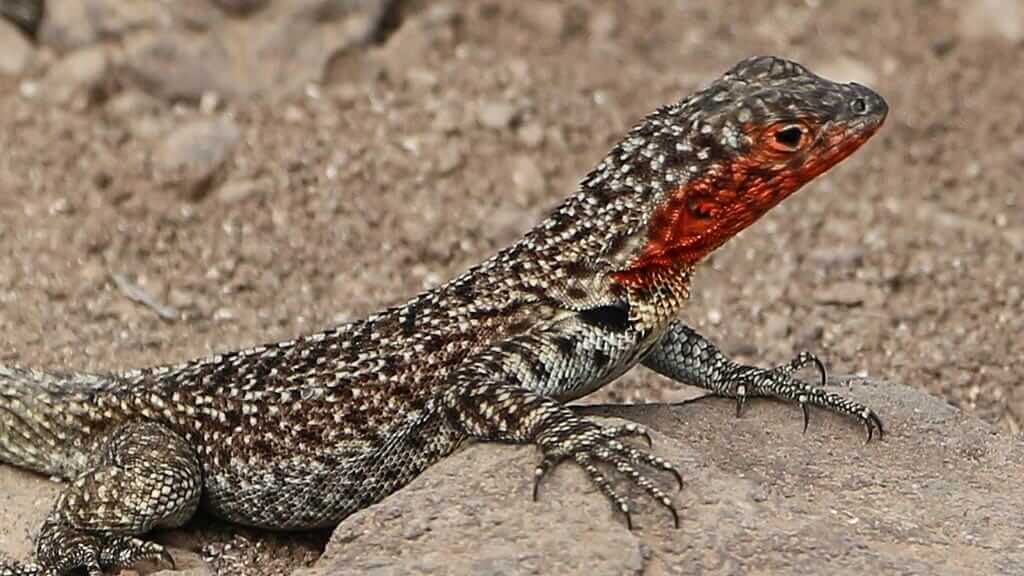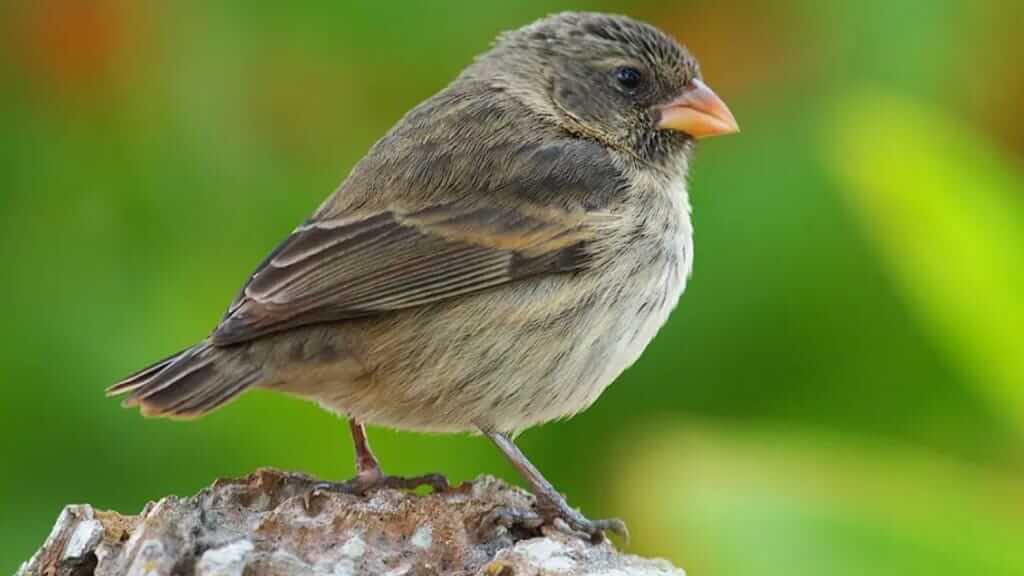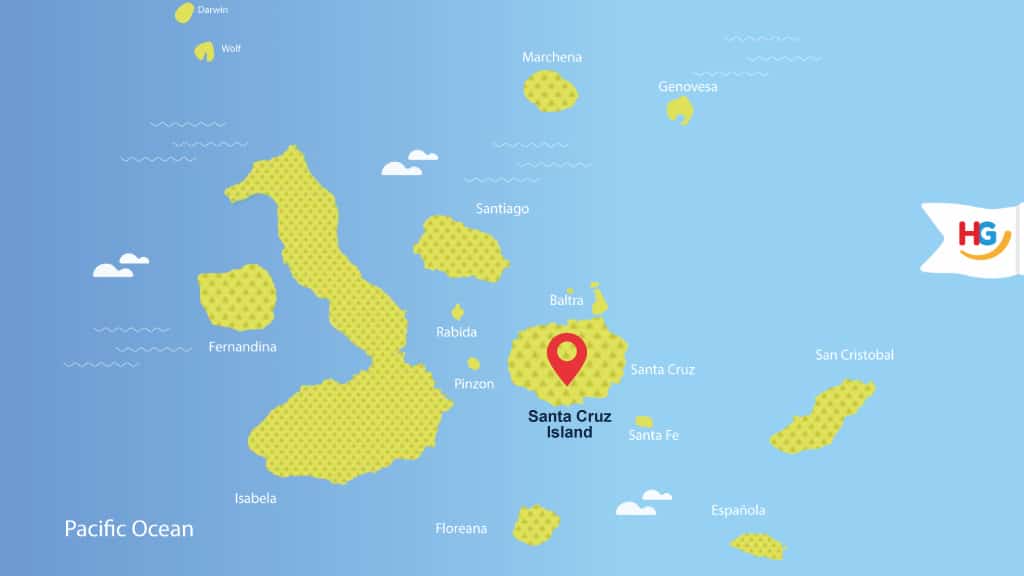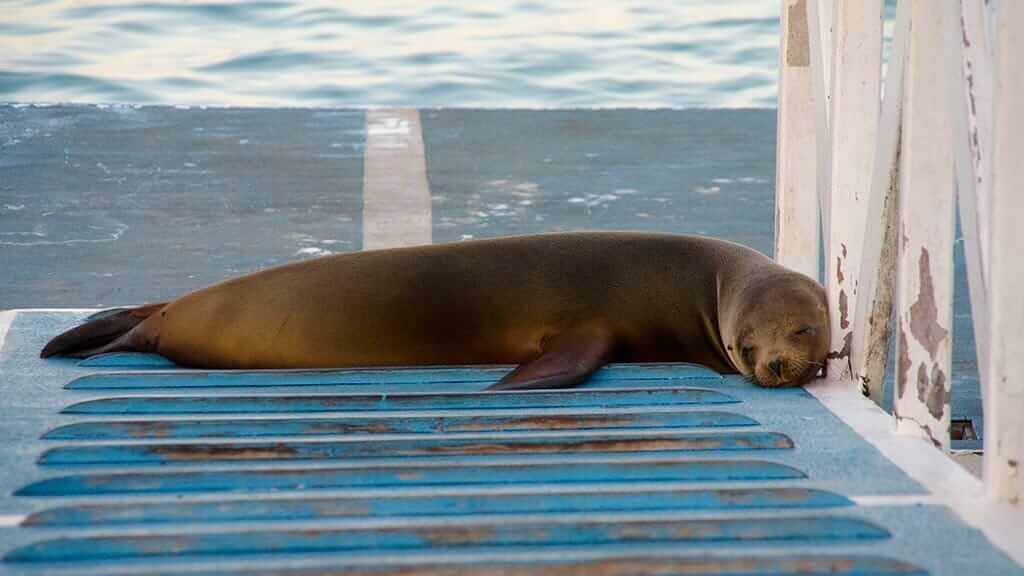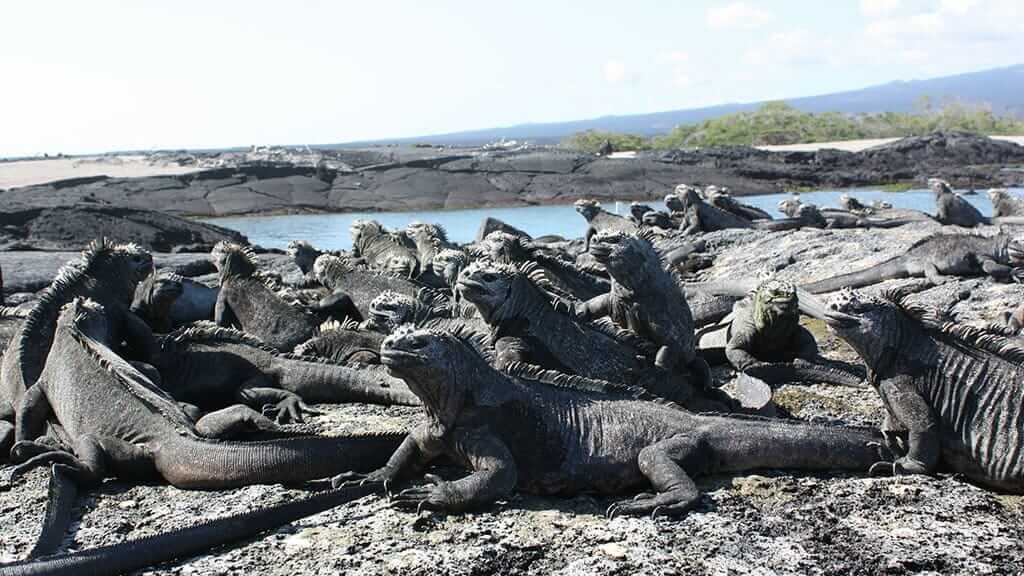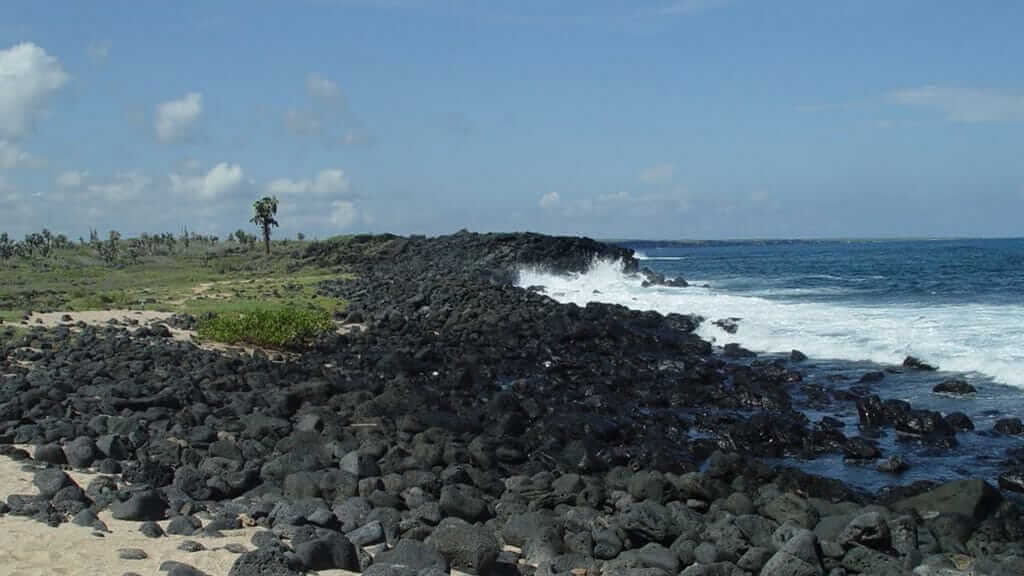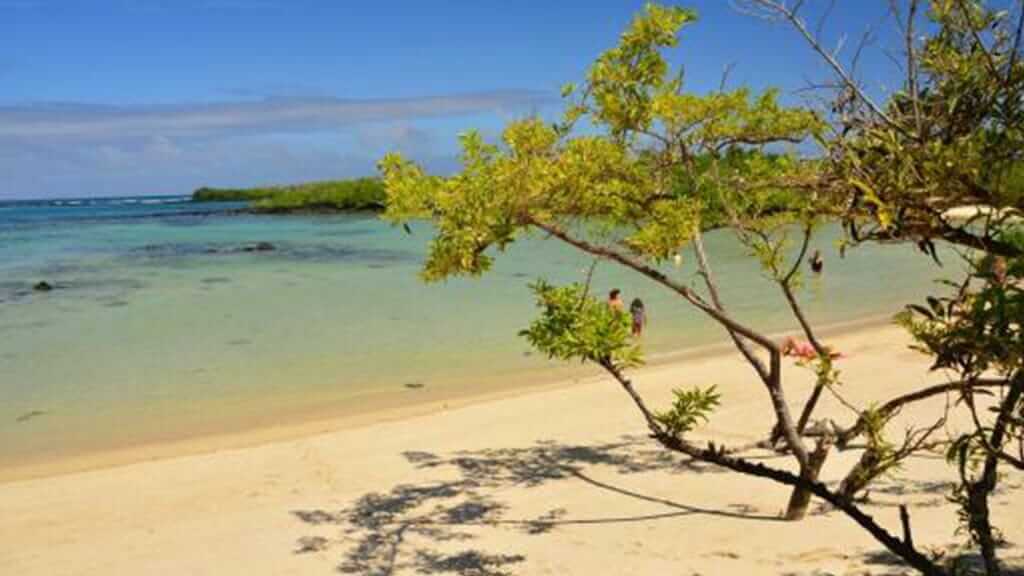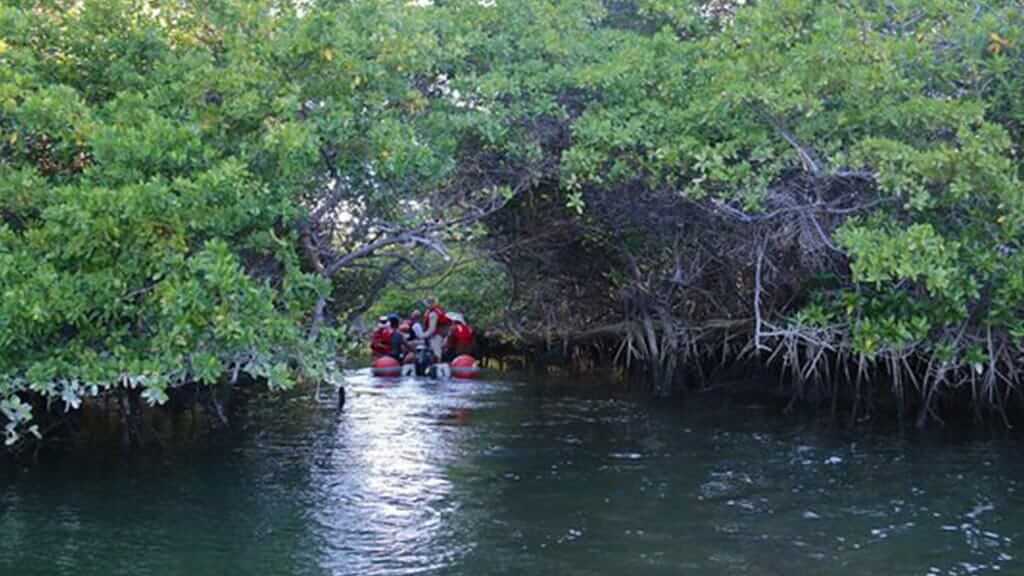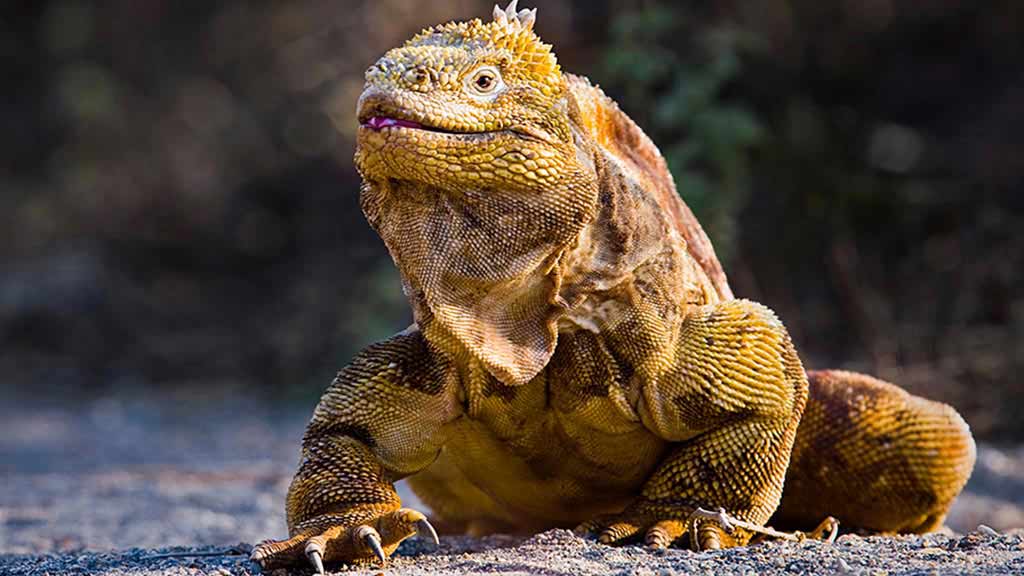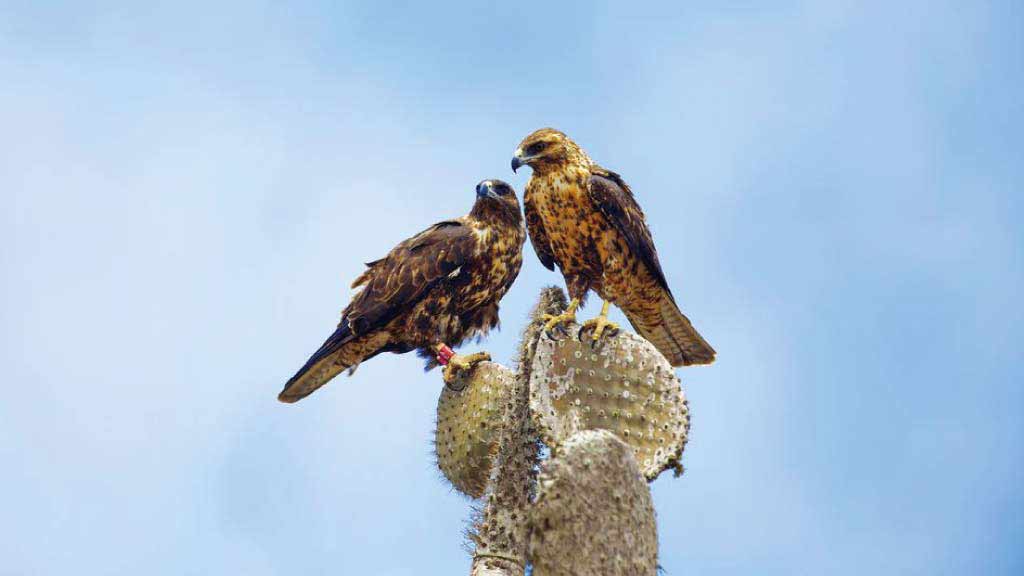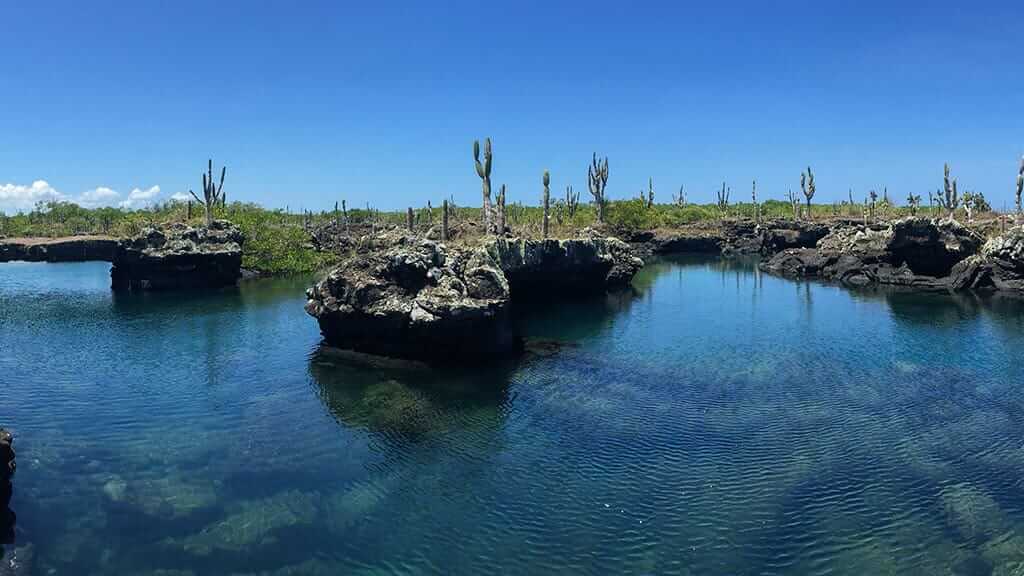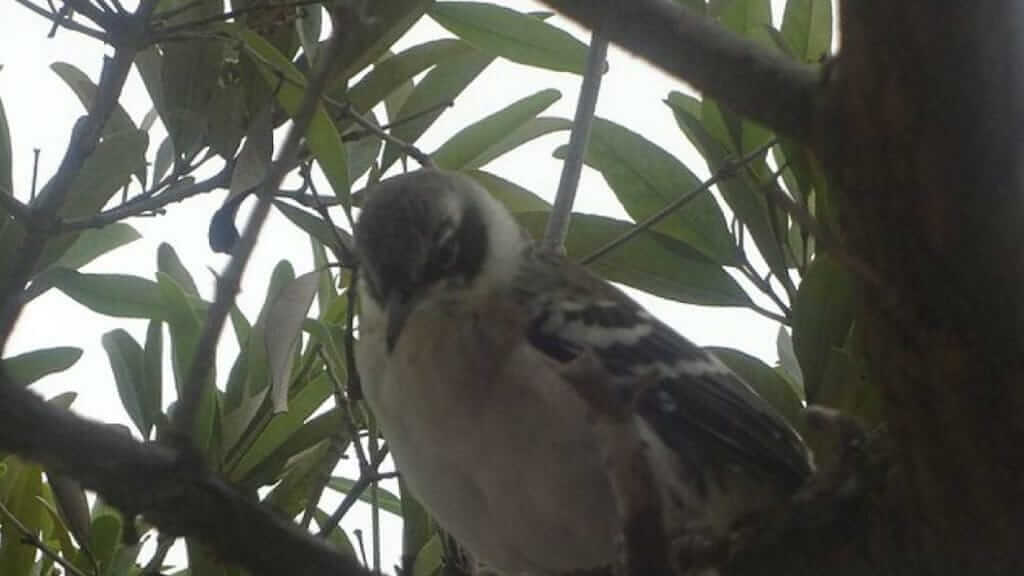Santa Cruz Galapagos Island
Santa Cruz Galapagos is the central hub for most visitors to the archipelago. Most cruise tourists will arrive and depart at Santa Cruz Galapagos. We think it's also worthy as a visitor site in its own right. The main port town of Santa Cruz Island is Puerto Ayora, packed with attractive boutiques, fine dining, vibrant social life, and oceanfront views over Academy Bay. Away from the town, the island’s stunning natural attractions on the coast and in the highlands appeal to locals and visitors alike. Imagine windswept beaches, lush reserves with free-roaming giant tortoises, spectacular volcanic craters to explore, and inviting turquoise waters for snorkelers. Santa Cruz Galapagos Island has something for everyone, so be sure to include some quality time here during your Galapagos Islands vacation.
Keep reading for everything you need to know to plan your visit to Santa Cruz Island Galapagos. What wildlife to spot here, and where? Which activities to enjoy? Where are the best Santa Cruz visitor sites? Plus, learn about the interesting geology & human history of this island.
SECURE YOUR GALAPAGOS TRAVEL
Get a FREE personalised quote todaySanta Cruz Galapagos Wildlife Highlights
• See Galapagos giant tortoises in their natural habitat at El Chato Reserve, up on the highlands of Santa Cruz Island. These gentle giants roam the dense vegetation and cool off in inviting mud pools.
• The many pristine beaches of Santa Cruz Galapagos are home to diverse wildlife including blue-footed boobies, marine iguanas, sea lions, and lava lizards.
• Some of the very best Galapagos day dive sites lay off the coast of Santa Cruz. Share the depths with inquisitive hammerheads, Galapagos Sharks, and an array of colorful reef fish.
• The Charles Darwin Research Station in Puerto Ayora is not to be missed. Their Fausto Llerena tortoise breeding center is home to cute baby tortoises as well as Santa Cruz land iguanas.
• Black Turtle Cove on the north coast of Santa Cruz Galapagos Island is a great spot to observe white-tip reef sharks, Galapagos rays, Pacific Green sea turtles, and more.
• You don’t even have to leave town for some fun wildlife experiences. The Puerto Ayora Fish Market is frequented by brown pelicans and sea lions waiting for offcuts of the day's catch.
About Santa Cruz Island Galapagos
English Name: Indefatigable.
Ecuadorian Name: Santa Cruz.
Total Area: 381 sq miles.
Population: Approx 18,000.
The original English island name for the island was in honor of the formidable British warship HMS Indefatigable, who made a name for herself during the Napoleonic wars in Europe. The name was later changed to Santa Cruz Island for its religious significance, meaning “Holy Cross” in Spanish.
Santa Cruz Galapagos Geology
Santa Cruz island is a dormant volcano that last erupted over 1 and 1/2 million years ago. Today there is still plenty of evidence of this explosive volcanic past. Black and rusty colored volcanic rocks are visible across the island, the testimony of ancient lava flows. The twin craters (Los Gemelos) are collapsed magma chambers, and there are also various lava tubes to be found close by in the highlands.
Santa Cruz Island Habitat
Santa Cruz is the most diverse Galapagos island, boasting six distinct vegetation zones.
Up at the highest altitudes of Santa Cruz, from 400 to 800 meters above sea level, we find the Miconia forest upland zone. Heading lower we pass through the Brown zone of smaller shrubs, then the moist Scalesia zone of cloud forest. These highland areas are often shrouded in clouds, where the cool and humid climate provides the perfect home for giant tortoises, Darwin Finches, and Flycatchers.
Lower still is the Transitional zone, where the drier climate starts to become more evident. This leads into the Arid zone so typical of many islands at Galapagos. These dry conditions are perfect for the Opuntia prickly pear cactus, Palo Santo tree, and scrubland species, home to land iguanas and lava lizards.
Finally, we reach the coastal zone of Santa Cruz Galapagos. The shoreline is a combination of black lava rocks and sandy beaches. Mangroves adapt to survive by filtering salt water for moisture and forming an important nursery ecosystem for sea creatures to hide away from predators. Brackish lagoons attract Galapagos flamingos, pintail ducks, and other waders.
Santa Cruz Galapagos - Human History
As you would expect from the most populated Galapagos island, Santa Cruz has a rich history of early human settlement at the archipelago. Early settlers came from Europe and North America between the two world wars, and Santa Cruz Island was a logical choice due to its diverse mix of habitats and fertile highland soils. The small towns of Bellavista and Santa Rosa were established in humid zones, with residents dedicated to cattle farming and agriculture of sugarcane, guava, coffee, banana, avocado, and citric fruits.
Some migrants preferred to chance their arms down on the coast. The Angermeyer family is famous for settling across Academy Bay, where the upscale Angermeyer Inn and restaurant still serves tourists today. For an idea of what daily life must have been like for the first settlers, pick up a copy of “My Father’s Island: A Galapagos Quest” by Johanna Angermeyer. It leaves no doubt that the dream Robinson Crusoe lifestyle was in fact a tough fight for survival at Galapagos.
In more recent history, a second world war base was set up at nearby Baltra island, the site of the principal Galapagos airport today. The islands were seen as a strategic site to defend the Pacific from Germans or Japanese invasion. Some remnants of that past can still be seen today, such as the ruins of a military barge on Las Bachas Beach Santa Cruz, now a handy perch for seabirds.
Where is Santa Cruz Galapagos Island?
How to get to Santa Cruz Galapagos? For tourists who arrive at Seymour Airport on Baltra Island, it’s just a short ferry ride across the Itabaca Channel to reach Santa Cruz Island. From there, a straight 25-mile road leads over the highlands to Puerto Ayora town on the opposite coast. From here the world is your oyster – stay a few days to explore visitor sites on the island by yourself, take day trips to nearby islands or join a liveaboard cruise to head further afield. Daily speed boats also transport tourists and locals to Isabela and San Cristobal islands.
Contact us for a FREE TOUR QUOTE, or for more information to plan your Galapagos vacation.
Puerto Ayora - The Main Town On Santa Cruz Island
Today, Puerto Ayora is a far cry from the port that greeted the original settlers of Santa Cruz. The town has plenty of restaurants, shops, and hotels to suit travelers of all shapes and sizes. The headquarters of the Galapagos National Park and the Charles Darwin Research Station are also located here. These two organizations work in tandem to protect and preserve the natural diversity and wildlife of the islands.
Santa Cruz Galapagos Airport (code GPS) is in fact not on Santa Cruz island at all, but is based on nearby Baltra to the north. The two islands are separated by the Itabaca channel, crossed by a regular ferry service. Various flights arrive here from Quito and Guayaquil on mainland Ecuador every day of the week. Visitors who stay overnight in Puerto Ayora can choose from a large selection of hotels on Santa Cruz Galapagos, suiting all tastes and budgets. For seclusion and relaxation, there are also top-end hotels across from Academy Bay such as Finch Bay Resort, or Royal Palm, and Pikaia Lodge up on the highlands.
Visitors to Puerto Ayora will find handy services such as a medical center, banks with ATMs, local airline offices, a supermarket, a pharmacy, and even a health spa.
The Santa Cruz Galapagos weather is generally similar to that of other parts of the Galapagos archipelago. For detailed information check out our Galapagos weather blog with details of average air and sea temperatures and rainfall throughout the year.
Another useful source of information for overnight visitors to Santa Cruz is our detailed blog post on how to spend a free day in Puerto Ayora. This post has more details about places to eat, drink, shop, and more.
Santa Cruz Galapagos Visitor Sites
There are lots of things to do in Santa Cruz Galapagos. Some of the more popular activities include trekking, biking, kayaking, paddle-boarding, snorkeling, and of course wildlife watching.
Keep reading for a list of the best visitor sites on Santa Cruz Island. Most of these sites are easy to visit by yourself, while some others require a tour or cruise with a naturalist guide.
Places to Visit Close to Puerto Ayora Town:
The Charles Darwin Research Station
The Charles Darwin Research Station (CDRS) was founded in 1959, the same year that the Galapagos National Park was established. It is host to hundreds of scientists and volunteers each year, who carry out valuable research in the islands that contribute to the preservation of the islands and their wildlife.
Located a short 15-minute walk from town, the station is also home to the Fausto Llerena tortoise breeding center. A visit to these facilities walks you through the different stages of Galapagos tortoise growth, from baby hatchling to adulthood. This center plays a vital role in the protection and conservation of the giant tortoise. Baby tortoises are under threat in the wild from invasive introduced species like dogs, cats, goats, and pigs, so the breeding center gives them a helping hand. By gathering up tortoise eggs and incubating them at the center, baby tortoises have a protected start to life. Once they grow large enough to fend for themselves they are reintroduced to the wild. Given that 6 of the 12 remaining Galapagos tortoise species are listed as critically endangered, the conservation work carried out by the breeding center gives new hope to avoid species extinction.
CDRS and the Galapagos National Park have successfully reintroduced giant tortoises to islands whose populations have been rendered extinct including Floreana and Santa Fe. Other parts of the tour explain the natural history of the islands and the work that CDR is doing around the archipelago.
Las Grietas Swimming Hole
Another site very close to Puerto Ayora town, Las Grietas is the best swimming hole on Santa Cruz island. Three crystal clear pools lie sandwiched in a crevasse between high volcanic walls. Locals and tourists alike flock here to cool off while enjoying the spectacular views. Whether swimming, snorkeling, or cliff diving, Las Grietas is a wonderful spot to while away a few relaxing hours!
The water at Las Grietas is a mix of seawater that enters from one end, and freshwater that filters in from the other. The protected walls mean that the water is crystal clear and very calm with no current – perfect for a relaxing swim.
Las Grietas is especially popular with locals at weekends, so head out early to avoid queues.
GET FREE ADVICE
From a Galapagos destination expert todayTop 5 Santa Cruz Galapagos Beaches:
The pristine, tropical beaches of Santa Cruz are picture-perfect places where sea lions, sally lightfoot crabs, sea turtles, marine iguanas, and flamingos mingle on swathes of sand under the sunny, blue skies of the island. The waters and offshore coral reefs are brimming with sea life, where vibrant schools of fish span the colors of the rainbow, and reef sharks lurk on the sea bed. Blue-footed boobies and Frigate birds hover in the skies, looking for a meal.
1. Tortuga Bay Beach
Tortuga Bay, an exceptionally beautiful tropical beach that is included on several lists of the world’s best beaches, is southwest of Puerto Ayora. The trailhead starts after a short walk from town and winds through mangroves and cactus forests along the coast. At the end of the mile-and-a-half walk, the scenery opens up into a tropical paradise that draws travelers and wildlife alike.
The first stretch of white sand is Playa Brava, where marine iguanas sun themselves on the warm, soft sand amidst the stunning turquoise waters offshore. This is the place to surf, and locals are often spotted hanging out early in the morning before the midday sun sets in.
At the end of Playa Brava lies Playa Mansa, a protected lagoon where a large colony of marine iguanas lives. The calm waters are ideal for swimming or kayaking, with boats available for rent by the hour.
Tortuga Bay Beach is a highly recommended and cheap way to spend a relaxing day by yourself in Santa Cruz Galapagos.
2. Garrapatero Beach
Located northeast of Puerto Ayora, El Garrapatero is a windswept stretch of beach reached after a 15-minute walk through a towering cactus forest. Manchineel trees, one of the world’s most poisonous trees, also line the path. The deadly trees and their fruit are clearly marked but keep in mind that contact with the sap alone can cause a severe rash.
Wildlife found at El Garrapatero makes exploring a mix of active endeavors and observation. Sea lions greet sun lovers on the beach, flamingos feed in the lagoon in the mangroves a short walk inland, finches fly in the branches overhead, and the tidal pool off the coast is a great place to snorkel and swim with sea turtles and lions, reef fish, and marine iguanas.
The trailhead is located over 10km outside of Puerto Ayora, so most tourists either rent a bicycle for the day or take a taxi out here. The plus side is that you’ll often have the beach to yourself, especially during midweek.
3. Bachas Beach
Located on the northern tip of Santa Cruz Galapagos Island, Bachas Beach is a popular stop on Galapagos cruises and day tours. This small stretch of beach boasts pristine white sand and turquoise waters and is an important sea turtle nesting site on the islands.
During nesting season, from January until June, early morning visits lead to discoveries of turtle tracks in the sand. Keep an eye out for postings from the Galapagos National Park marking protected areas.
The name Las Bachas translates as “The Barges” in English. The U.S. Navy abandoned two ships here from their base on nearby Balta Island after the end of WWII. Visitors today can see the rusted barge sides peaking out from under the sand.
Las Bachas is a pleasant swimming beach where visitors share the crystalline waters with marine iguanas, sea lions, and reef sharks. Sally-lightfoot crabs hide in lava crevasses, and flamingos can be found in the nearby saltwater lagoon behind the beach. Finches, warblers, gulls, whimbrels, and blue-footed boobies are just a few of the birds that fly overhead and wade in the shallows.
4. Playa de Los Perros
Playa de Los Perros, nearby to Puerto Ayora, is reached by a short water taxi ride from town. The small islet and the nearby pool are the places to find marine iguanas and white-tipped reef sharks.
The clear waters lend themselves to snorkeling with brightly-colored, exotic fish while blue-footed boobies circle overhead in search of their next meal.
5. Playa de Los Alemanes
On the way to Las Grietas, Playa de Los Alemanes is a charming Santa Cruz beach for swimming, snorkeling, surfing, and kayaking. After a short water taxi ride across Academy Bay from Puerto Ayora, a short hike on a marked trail ends at a boardwalk that surrounds the beach.
Santa Cruz Galapagos Visitor Sites For Cruise Passengers:
Black Turtle Cove (Caleta Tortuga Negra)
Black Turtle Cove, on the northern coast of Santa Cruz Island, is a peaceful cove surrounded by mangroves. This site is only reached as part of a cruise itinerary, where naturalist guides take groups on a panga (zodiac) ride through the shallow waters in search of wildlife.
Three kinds of mangroves grow around Black Turtle Cove – red, white, and black. The mangrove ecosystem is very important for many marine species in Galapagos, acting as a sanctuary for small, vulnerable creatures and a nursery for baby sharks, providing safety from dangerous predators.
The Galapagos National Park’s rules require that the motor of pangas are turned off when approaching the cove to avoid disturbing wildlife. It is common to spot sea turtles, and a variety of sharks and rays swimming in the clear, shallow waters. This sanctuary is also home to blue-footed boobies, pelicans, and herons.
Cerro Dragon (Dragon Hill)
Dragon Hill on the northwest coast of Santa Cruz Island owes its interesting name to the population of land iguanas that call this rocky hill home. Abundant forests of Opuntia Cactus provide iguanas with their favorite food – juicy fruit or prickly cactus pads. These yellow “dragons” wait in the shade of large cactus plants, waiting for a meal to drop from the branches straight onto their plate.
Other wildlife treats that await cruise passengers at Dragon Hill include flamingos, Galapagos finches, yellow warblers, boobies, and frigates.
Whale Bay (Bahia Ballena)
Whale Bay Santa Cruz is a green sand beach that whalers would use as a harbor and camp to load up with giant tortoises as food for onward voyages. The unusual sand coloring is due to a high concentration of olivine mineral crystals. Whale Bay is a great spot to look out for Galapagos hawks, as well as finches, boobies, frigates, sea lions, and marine iguanas.
Top 5 Places to Visit in Santa Cruz Galapagos Highlands:
The highlands of Santa Cruz, just 10-15km from Puerto Ayora town, seem like a completely different world when compared to the beaches and fine weather on the coast. The highlands are often shrouded in mist, with lush green vegetation everwhere you look. The good news for visitors is that there are some great places to visit in the highlands, with a diversity of wildlife you will not have seen at lower altitudes.
1. El Chato Tortoise Reserve
Founded in 1964, El Chato Tortoise Reserve is close to the small town of Santa Rosa. The reserve is split into two parts, La Caseta and Cerro Chato. Cerro Chato’s trails are well-marked and the easiest to navigate, while the overgrown paths of La Caseta present more of a challenge. La Caseta is sometimes closed by Galapagos National Park rangers who work in the area building walls to protect Giant Tortoises from predators including wild pigs and dogs.
The trails and ponds of both sections provide the ideal ecosystem to see giant lumbering tortoises in their natural habitat. They’ll usually be found moving slowly through the fertile flora, resting peacefully under the shade of trees, or cooling off in ponds or mud pools.
2. Twin Craters (Los Gemelos)
The Twin Craters are a pair of massive magma chambers whose roofs collapsed, leaving sinkholes for visitors to enjoy. Located just past Santa Rosa town, these impressive overgrown pit craters are surrounded by Scalesia forest, where different species of Darwin’s finches, Vermilion flycatchers, and short-eared owls live in the branches.
Trails skirt around the rim of both craters, under a canopy of trees that grow up to 65 ft. tall. The Scalesia tree is endemic to the Galapagos, and thanks to the efforts of conservationists, the forest around Los Gemelos is one of the largest on the islands.
3. Lava Tunnels
Santa Cruz Island highlands are home to the largest accessible lava tunnels (or lava tubes) on the Galapagos islands. Lava tunnels are formed when slow-moving surface lava solidifies, while faster-moving lava continues to flow underneath, leaving a hollow tube behind after the eruption ends. The Santa Cruz Galapagos lava tunnels were formed over 1 million years ago, and some are large enough to walk inside.
Descending into the earth and exploring these lit tunnels is an adventure that uncovers the origins of Santa Cruz, bringing to light the volcanic explosions that formed the island. Take a flashlight with you, and take care where you tread as the tunnel ceilings are fragile and some are in a state of collapse due to erosion.
4. Steve Devine’s Butterfly Farm
Located between the towns of Santa Rosa and Bellavista on Santa Cruz highlands, Steve Devine’s Butterfly Farm is a private farm where hoards of giant tortoises roam the large estate. The Devine family is part of the original settlers of the island, moving to Santa Cruz in 1949. Besides the butterflies, more than twenty species of Galapagos birds can be spotted on their 500-acre property, including owls, flycatchers, finches, mockingbirds, and doves. The farm’s restaurant and café are a relaxing place to take in the scenery over a coffee or tea before heading on to the next stop.
5. Galapagos Coffee Farms
The highlands of Santa Cruz have several coffee farms that are open to the public such as Lava Java and El Trapiche. Visits take you through the coffee growing process from growing the beans to the final product. El Trapiche also grows sugar cane, where visitors can watch the cane being processed by a centuries-old, mule-driven grinder.
Top 3 Santa Cruz Galapagos Dive Sites:
Santa Cruz Galapagos dive sites are accessed on scuba day tours, where operators provide all of the equipment and guidance required to explore the underwater wonders of the Galapagos. Usually dive day tours include two immersions, and the different sites have difficulty ratings ranging from beginners to experienced divers. The Galapagos Islands are considered to be one of the best places on the planet for scuba divers. The vast underwater world of the Galapagos Marine Reserve is home to sharks, rays, hundreds of species of fish, underwater canyons, and sheer coral reefs.
1. Guy Fawkes Rocks
Guy Fawkes Rocks is a dive site composed of four islets on the northwest coast of Santa Cruz Island. This is an intermediate site at depths of 80 ft. opening into sheer coral slopes with cavities where white-tipped reef sharks feed. Green sea turtles, eagle rays, and sea lions also frequent the area.
2. Punta Carrión
A beginner to intermediate dive on the western coast of Santa Cruz, Punta Carrión has depths that reach 90ft. below the surface. Marine life to keep your eyes peeled for includes marbled and eagle rays, sea lions and turtles, white-tipped reef sharks, scorpion fish, brightly colored reef fish, and if lucky the occasional hammerhead shark. During the guara mist season, dolphins may also be spotted in the area.
3. Gordon Rocks
Located off the eastern coast of Santa Cruz Galapagos, Gordon Rocks is renowned as one of the very top dive sites on the Galapagos islands. Strong currents mean that this is a site for intermediate and advanced divers. The submerged, eroded cone of an extinct tuff cone volcano, is home to a great number of white-tipped, Galapagos and (in season) hammerhead sharks.
There is a 90ft. or 30 meters drop to the sandy sea floor. Nicknamed the “washing machine,” because of the strong currents and coral walls. Gordon Rocks not only attracts sharks, but also mammoth Mola Mola (Sun Fish), Green sea turtles, schools of barracuda, manta, sting and marbled rays, eels, yellowtail surgeonfish, and king angelfish. For diving enthusiasts, Gordon Rocks is not to be missed!
The #1 Trusted
Galapagos Travel Agency
In conclusion, Santa Cruz Galapagos Island is one of the best islands for visitors to spend time in. Santa Cruz Island boasts a great diversity of visitor sites and wildlife, plus heaps of fun adventure activities to keep you busy. The port town of Puerto Ayora is a vibrant place to hang out while shopping for gifts and souvenirs, enjoying al fresco fine dining and cocktails, and mixing with the friendly locals. Many tourists include a few days of downtime to enjoy Santa Cruz either before or after their Galapagos tours – a choice that we highly recommend!



